Regulation Mechanisms of Water and Nitrogen Coupling on the Root-Zone Microenvironment and Yield in Drip-Irrigated Goji Berries
Abstract
1. Introduction
2. Materials and Methods
2.1. Experimental Area
2.2. Design of the Experiment
2.3. Collection of Soil Samples
2.4. Indicator Methods and Measurements
2.4.1. Soil Indicator Determination and Methods
2.4.2. Comprehensive Evaluation of the Quality of Soil
- (1)
- The minimum data set (MDS) method was used for evaluating soil quality, i.e., 12 indicators including SOM, TP, TN, TK, NH4+-N, NO3−-N, AP, UA, AK, SA, HPA, and APA of the soil in the bloom season were used to establish the total soil data set (TDS) [23]. The TDS was determined after running a one-way ANOVA for each indicator (one-way ANOVA). The TDS showing a significant difference (p < 0.05) was selected as the minimum data set (MDS) indicator [24].
- (2)
- Next, MDS was constructed through principal component analysis (PCA)—norm values—and Pearson’s correlation [25]. Norm value represents the vector norm length of the indicator in the multidimensional component space. With increasing length, the comprehensive load of the indicator across all principal components increases, and its ability to interpret comprehensive information also rises. The formula for calculating the norm value is as shown in Equation (1) [26].
- (3)
- The objective weighted coefficient of variation method was used to determine the indicator weights [8]. The indicator weights were determined using Equations (2) and (3).
- (4)
- (5)
- The soil quality index (SQI) was calculated subsequently to scoring and weighting all the indicators in the MDS. This was achieved using the scoring function [29], which quantifies the criteria of each indicator on a 0–1 scale.
2.4.3. Goji Berry Yield
2.4.4. Statistical Methods Applied
3. Results
3.1. Characterisation of Total Soil Nutrients in the Root Zone of Goji Berry
3.2. Characteristics of Soil Nutrients in the Root Zone of Goji Berry
3.3. Characteristics of the Soil Enzyme Distribution in the Goji Berry Root Zone
3.3.1. Urease
3.3.2. Sucrase
3.3.3. Alkaline Phosphatase
3.3.4. Hydrogen Peroxidase
3.4. Indicators of Production
3.5. Comprehensive Analysis of Soil Traits and Yield Components
3.6. Evaluation of Quality of Soil and Its Relationship with Yield
4. Discussion
4.1. Effects of Coupling of N and Water on Soil Nutrients in the Root Zone of Goji Berry
4.2. Effects of N and Water Coupling on Soil Enzymes in the Root Zone of Goji Berry
4.3. Influences of N and Water Coupling on Yield Formation
5. Conclusions
Author Contributions
Funding
Data Availability Statement
Conflicts of Interest
References
- Wang, C.; Chang, S.; Inbaraj, B.S.; Chen, B. Isolation of carotenoids, flavon-oids and polysaccharides from Lycium barbarum L. and evaluation of anti-oxidant activity. Food Chem. 2010, 120, 184–192. [Google Scholar] [CrossRef]
- Amagase, H.; Farnsworth, N.R. A review of botanical characteristics, phytoc-hemistry, clinical relevance in efficacy and safety of Lycium barbarum frui-t (Goji). Food Res. Int. 2011, 44, 1702–1717. [Google Scholar] [CrossRef]
- Wang, L.; Wang, Y.; Zhou, P. Validation of reference genes for quantitative real-time PCR during Chinese wolfberry fruit development. Plant Physiol. Biochem. 2013, 70, 304–310. [Google Scholar] [CrossRef] [PubMed]
- Yin, W.; Zhang, C.; Zhu, H.; Zhao, Y.; He, Y. Application of near-infrared hyperspectral imaging to discriminate different geographical origins of Chinese wolfberries. PLoS ONE 2017, 12, e0180534. [Google Scholar] [CrossRef]
- Yin, J.; Ma, Z.; Yang, Y.; Du, B.; Sun, F.; Yang, Z. Water and Nitrogen Coupling on the Regulation of Soil Nutrient–Microbial Biomass Balance and Its Effect on the Yield of Wolfberry (Lycium barbarum L.). Plants 2023, 12, 2768. [Google Scholar] [CrossRef] [PubMed]
- Ma, Z.; Yin, J.; Yang, Y.; Sun, F.; Yang, Z. Effect of water and nitrogen coupling regulation on the growth, physiology, yield, and quality attributes and comprehensive evaluation of wolfberry (Lycium barbarum L.). Front. Plant Sci. 2023, 14, 1130109. [Google Scholar] [CrossRef] [PubMed]
- Su, Q.; Cang, B.; Ullah, R.; Song, Z.; Li, Y.; Cui, J.; Wei, X.; Yang, M.; Yang, X.; Wu, Z. Interaction of the coupled effects of irrigation mode and nitrogen fertilizer timing on rice yield in different regions. Irrig. Drain. 2023, 72, 999–1012. [Google Scholar] [CrossRef]
- Cabrera-Bosquet, L.; Molero, G.; Bort, J.; Nogués, S.; Araus, J.L. The combined effect of constant water deficit and nitrogen supply on WUE, NUE and Δ13C in durum wheat potted plants. Ann. Appl. Biol. 2007, 151, 277–289. [Google Scholar] [CrossRef]
- Huang, L.; Yang, W.P.; Hu, X.Q.; Tao, Y.; Yao, S.M.; Ou, X.Q. Effects of Irrigation and Nitrogen Interaction on Water Consumption Characteristics and Nitrogen Utilization of Winter Wheat. J. Soil Water Conserv. 2016, 30, 168–174. (In Chinese) [Google Scholar] [CrossRef]
- Li, Y.; Shao, X.; Li, D.; Xiao, M.; Hu, X.; He, J. Effects of water and nitrogen coupling on growth, physiology and yield of rice. Int. J. Agric. Biol. Eng. 2019, 12, 60–66. [Google Scholar] [CrossRef]
- Yang, Z.; Kong, T.; Xie, J.; Yang, T.; Jiang, Y.; Feng, Z.; Zhang, Z. Appropriate water and fertilizer supply can increase yield by promoting growth while ensuring the soil ecological environment in melon production. Agric. Water Manag. 2023, 289, 108561. [Google Scholar] [CrossRef]
- Zhong, T.; Zhang, J.; Du, L.; Ding, L.; Zhang, R.; Liu, X.; Ren, F.; Yin, M.; Yang, R.; Tian, P.; et al. Comprehensive evaluation of the water-fertilizer coupling effects on pumpkin under different irrigation volumes. Front. Plant Sci. 2024, 15, 6109. [Google Scholar] [CrossRef] [PubMed]
- Jin, Z.; Yue, R.; Ma, Z.; Cheng, S.; Khan, M.N.; Nie, L. Effect of water and nitrogen coupling on energy balance and production efficiency in rice production. Energy 2024, 288, 129739. [Google Scholar] [CrossRef]
- Shen, Y.; Li, S.; Shao, M. Effects of spatial coupling of water and fertilizer applications on root growth characteristics and water use of winter wheat. J. Plant Nutr. 2013, 36, 515–528. [Google Scholar] [CrossRef]
- Man, J.; Yu, J.; White, P.J.; Gu, S.; Zhang, Y.; Guo, Q.; Shi, Y.; Wang, D. Effects of supplemental irrigation with micro-sprinkling hoses on water distribution in soil and grain yield of winter wheat. Field Crops Res. 2014, 161, 26–37. [Google Scholar] [CrossRef]
- Sonko, E.; Tsado, D.N.; Yaffa, S.; Okhimamhe, A.A.; Eichie, J. Wet and Dry Season Effects on select soil nutrient contents of upland farms in North Bank region of the Gambia. Open J. Soil Sci. 2016, 6, 45. [Google Scholar] [CrossRef]
- Nozawa, S.; Hakoda, A.; Sakaida, K.; Suzuki, T.; Yasui, A. Method performance study of the determination of total nitrogen in soy sauce by the Kjeldahl method. Anal. Sci. 2005, 21, 1129–1132. [Google Scholar] [CrossRef]
- Ivanov, K.; Zaprjanova, P.; Petkova, M.; Stefanova, V.; Kmetov, V.; Georgieva, D.; Angelova, V. Comparison of inductively coupled plasma mass spectrometry and colorimetric determination of total and extractable phosphorus in soils. Spectrochim. Acta Part B At. Spectrosc. 2012, 71, 117–122. [Google Scholar] [CrossRef]
- Korda, T.M.; Petrova, N.I.; Beizel’, N.F.; Saprykin, A.I. Atomic-absorption spectrometric determination of catalytic components (Pd, Ti, and Cu) in mixtures based on phenol. J. Anal. Chem. 2008, 63, 151–156. [Google Scholar] [CrossRef]
- Song, S.-H.; Wen, Y.-J.; Zhang, J.-Y.; Wang, H. Rapid spectrophotometric measurement with a microplate reader for determining phosphorus in NaHCO3 soil extracts. Microchem. J. 2019, 146, 210–213. [Google Scholar] [CrossRef]
- Yang, E.; Zhao, X.; Qin, W.; Jiao, J.; Han, J.; Zhang, M. Temporal impacts of dryland-to-paddy conversion on soil quality in the typical black soil region of China: Establishing the minimum data set. Catena 2023, 231, 107303. [Google Scholar] [CrossRef]
- Ge, Y.; Wang, Q.; Wang, L.; Liu, W.; Liu, X.; Huang, Y.; Christie, P. Response of soil enzymes and microbial communities to root extracts of the alien Alternanthera philoxeroides. Arch. Agron. Soil Sci. 2018, 64, 708–717. [Google Scholar] [CrossRef]
- Yu, P.; Han, D.; Liu, S.; Wen, X.; Huang, Y.; Jia, H. Soil quality assessment under different land uses in an alpine grassland. Catena 2018, 171, 280–287. [Google Scholar] [CrossRef]
- Li, P.; Zhang, T.; Wang, X.; Yu, D. Development of biological soil quality indicator system for subtropical China. Soil Tillage Res. 2013, 126, 112–118. [Google Scholar] [CrossRef]
- Masto, R.E.; Chhonkar, P.K.; Singh, D.; Patra, A.K. Alternative soil quality indices for evaluating the effect of intensive crop**, fertilisation and manuring for 31 years in the semi-arid soils of India. Environ. Monit. Assess. 2008, 136, 419–435. [Google Scholar] [CrossRef]
- Guo, L.; Sun, Z.; Ouyang, Z.; Han, D.; Li, F. A comparison of soil quality evaluation methods for Fluvisol along the lower Yellow River. Catena 2017, 152, 135–143. [Google Scholar] [CrossRef]
- He, H.; Peng, M.; Lu, W.; Hou, Z.; Li, J. Commercial organic fertilizer substitution increases wheat yield by improving soil quality. Sci. Total Environ. 2022, 851, 158132. [Google Scholar] [CrossRef]
- Peng, M.; He, H.; Wang, Z.; Li, G.; Lv, X.; Pu, X.; Zhuang, L. Responses and comprehensive evaluation of growth characteristics of ephemeral plants in the desert–oasis ecotone to soil types. J. Environ. Manag. 2022, 316, 115288. [Google Scholar] [CrossRef]
- D’Hose, T.; Cougnon, M.; De Vliegher, A.; Vandecasteele, B.; Viaene, N.; Cornelis, W.; Van Bockstaele, E.; Reheul, D. The positive relationship between soil quality and crop production: A case study on the effect of farm compost application. Appl. Soil Ecol. 2014, 75, 189–198. [Google Scholar] [CrossRef]
- Yang, L.; Yang, Z.; Zhong, X.; Xu, C.; Lin, Y.; Fan, Y.; Wang, M.; Chen, G.; Yang, Y. Decreases in soil P availability are associated with soil organic P declines following forest conversion in subtropical China. Catena 2021, 205, 105459. [Google Scholar] [CrossRef]
- Vlek, P.L.G.; Kühne, R.F.; Denich, M. Nutrient resources for crop production in the tropics. Philos. Trans. R. Soc. London. Ser. B Biol. Sci. 1997, 352, 975–985. [Google Scholar] [CrossRef]
- Shrivastav, P.; Prasad, M.; Singh, T.B.; Yadav, A.; Goyal, D.; Ali, A.; Dantu, P.K. Role of nutrients in plant growth and development. In Contaminants in Agriculture: Sources, Impacts and Management; Springer: Cham, Switzerland, 2020; pp. 43–59. [Google Scholar] [CrossRef]
- Bouwman, A.F.; Beusen, A.H.W.; Lassaletta, L.; van Apeldoorn, D.F.; van Grinsven, H.J.M.; Zhang, J.; van, M.K.I. Lessons from temporal and spatial patterns in global use of N and P fertilizer on cropland. Sci. Rep. 2017, 7, 40366. [Google Scholar] [CrossRef]
- Vejan, P.; Khadiran, T.; Abdullah, R.; Ahmad, N. Controlled release fertilizer: A review on developments, applications and potential in agriculture. J. Control. Release 2021, 339, 321–334. [Google Scholar] [CrossRef]
- Zhang, M.; Cheng, G.; Feng, H.; Sun, B.; Zhao, Y.; Chen, H.; Chen, J.; Dyck, M.; Wang, X.; Zhang, J.; et al. Effects of straw and biochar amendments on aggregate stability, soil organic carbon, and enzyme activities in the Loess Plateau, China. Environ. Sci. Pollut. Res. 2017, 24, 1–13. [Google Scholar] [CrossRef] [PubMed]
- Gou, Z.H.; Qin, Q.J.; Lv, J.; Che, X.S.; Luo, J.; Zhang, H.; Zhang, G.B. Effects of different water and fertilizer combinations on yield of purple cabbage and soil physical and chemical properties on plateau in summer. Agric. Res. Arid. Areas 2021, 39, 137–144. [Google Scholar]
- Biswas, T.; Kole, S.C. Soil organic matter and microbial role in plant productivity and soil fertility. In Advances in Soil Microbiology: Recent Trends and Future Prospects. Microorganisms for Sustainability; Springer: Singapore, 2017; Volume 4, pp. 219–238. [Google Scholar] [CrossRef]
- Ben-Noah, I.; Friedman, S.P. Review and evaluation of root respiration and of natural and agricultural processes of soil aeration. Vadose Zone J. 2018, 17, 1–47. [Google Scholar] [CrossRef]
- Lei, H.; Yu, J.; Zang, M.; Pan, H.; Liu, X.; Zhang, Z.; Du, J. Effects of water-fertilizer-air-coupling drip irrigation on soil health status: Soil aeration, enzyme activities and microbial biomass. Agronomy 2022, 12, 2674. [Google Scholar] [CrossRef]
- Wu, P.; Guo, Z.; Hua, K.; Wang, D. Long-term application of organic amendments changes heavy metals accumulation in wheat grains by affecting soil chemical properties and wheat yields. J. Soils Sediments 2023, 23, 2136–2147. [Google Scholar] [CrossRef]
- Badr, M.A.; El-Tohamy, W.A.; Zaghloul, A.M. Yield and water use efficiency of potato grown under different irrigation and nitrogen levels in an arid region. Agric. Water Manag. 2012, 110, 9–15. [Google Scholar] [CrossRef]
- Liu, S.; Lin, X.; Wang, W.; Zhang, B.; Wang, D. Supplemental irrigation increases grain yield, water productivity, and nitrogen utilization efficiency by improving nitrogen nutrition status in winter wheat. Agric. Water Manag. 2022, 264, 107505. [Google Scholar] [CrossRef]
- Si, Z.; Zain, M.; Mehmood, F.; Wang, G.; Gao, Y.; Duan, A. Effects of nitrogen application rate and irrigation regime on growth, yield, and water-nitrogen use efficiency of drip-irrigated winter wheat in the North China Plain. Agric. Water Manag. 2020, 231, 106002. [Google Scholar] [CrossRef]
- Hu, Y.; Zhang, F.; Javed, H.H.; Peng, X.; Chen, H.; Tang, W.; Lai, Y.; Wu, Y. Controlled-release nitrogen mixed with common nitrogen fertilizer can maintain high yield of rapeseed and improve nitrogen utilization efficiency. Plants 2023, 12, 4105. [Google Scholar] [CrossRef]
- Yi, Z.; Jeyakumar, P.; Yin, C.; Sun, H. Effects of biochar in combination with varied N inputs on grain yield, N uptake, NH3 volatilization, and N2O emission in paddy soil. Front. Microbiol. 2023, 14, 1174805. [Google Scholar] [CrossRef]
- Wang, N.; Zhan, J.; Feng, K.; Qi, J.; Nan, H. Higher yield sustainability and soil quality by reducing chemical fertilizer with organic fertilizer application under a single-cotton croping system. Front. Plant Sci. 2024, 15, 1494667. [Google Scholar] [CrossRef] [PubMed]
- Xu, J.; Wang, X.; Ding, Y.; Mu, Q.; Cai, H.; Ma, C.; Saddique, Q. Effects of irrigation and nitrogen fertilization management on crop yields and long-term dynamic characteristics of water and nitrogen transport at deep soil depths. Soil Tillage Res. 2020, 198, 104536. [Google Scholar] [CrossRef]
- Li, S.; Chen, Y.; Li, T.; Yu, F.; Zhang, Y.; Liu, K.; Zhang, H.; Gu, J.; Yang, J.; Liu, L. Alternate wetting and moderate soil drying irrigation counteracts the negative effects of lower nitrogen levels on rice yield. Plant Soil 2022, 481, 367–384. [Google Scholar] [CrossRef]
- Su, F.; Wu, J.; Wang, D.; Zhao, H.; Wang, Y.; He, X. Moisture movement, soil salt migration, and nitrogen transformation under different irrigation conditions: Field experimental research. Chemosphere 2022, 300, 134569. [Google Scholar] [CrossRef]
- Utobo, E.B.; Tewari, L. Soil enzymes as bioindicators of soil ecosystem status. Appl. Ecol. Environ. Res. 2015, 13, 147–169. [Google Scholar] [CrossRef]
- Nannipieri, P.; Trasar-Cepeda, C.; Dick, R.P. Soil enzyme activity: A brief history and biochemistry as a basis for appropriate interpretations and meta-analysis. Biol. Fertil. Soils 2018, 54, 11–19. [Google Scholar] [CrossRef]
- Sharma, S.; Sharma, N.; Gupta, N.; Angmo, P.; Siddiqui, M.H.; Rahman, A. Impact of chemically diverse organic residue amendment on soil enzymatic activities in a sandy loam soil. Agronomy 2023, 13, 1719. [Google Scholar] [CrossRef]
- Tfaij, A.L.; Al-Ansari, A.M.S.; Jaberi, M.M.A. Activity and Thermodynamic Parameters of Urease Enzymes in Soils Treated with Some Heavy Metals Under Different Temperatures and Moisture Levels. Basrah J. Agric. Sci. 2019, 32, 193–206. [Google Scholar] [CrossRef]
- Zhang, Y.; Cui, D.; Yang, H.; Kasim, N. Differences of soil enzyme activities and its influencing factors under different flooding conditions in Ili Valley, Xinjiang. PeerJ 2020, 8, e8531. [Google Scholar] [CrossRef]
- Hennion, N.; Durand, M.; Vriet, C.; Doidy, J.; Maurousset, L.; Lemoine, R.; Pourtau, N. Sugars en route to the roots. Transport, metabolism and storage within plant roots and towards microorganisms of the rhizosphere. Physiol. Plant. 2019, 165, 44–57. [Google Scholar] [CrossRef]
- Tang, B.; Xu, H.; Song, F.; Ge, H.; Chen, L.; Yue, S.; Yang, W. Effect of biochar on immobilization remediation of Cd⁃ contaminated soil and environmental quality. Environ. Res. 2022, 204, 111840. [Google Scholar] [CrossRef] [PubMed]
- Song, W.; Han, F.; Bao, Z.; Chai, Y.; Wang, L.; Huang, C.; Cheng, H.; Chang, L. Mulching practices improve soil moisture and enzyme activity in drylands, increasing potato yield. Agronomy 2024, 14, 1077. [Google Scholar] [CrossRef]
- Azene, B.; Zhu, R.; Pan, K.; Sun, X.; Nigussie, Y.; Gruba, P.; Raza, A.; Guadie, A.; Wu, X.; Zhang, L. Land use change alters phosphatase enzyme activity and phosphatase-harboring microbial abundance in the subalpine ecosystem of southeastern Qinghai-Tibet Plateau, China. Ecol. Indic. 2023, 153, 110416. [Google Scholar] [CrossRef]
- Basu, N.B.; Van Meter, K.J.; Byrnes, D.K.; Van Cappellen, P.; Brouwer, R.; Jacobsen, B.H.; Jarsjö, J.; Rudolph, D.L.; Cunha, M.C.; Nelson, N.; et al. Managing nitrogen legacies to accelerate water quality improvement. Nat. Geosci. 2022, 15, 97–105. [Google Scholar] [CrossRef]
- Khan, F.; Siddique, A.B.; Shabala, S.; Zhou, M.; Zhao, C. Phosphorus plays key roles in regulating plants’ physiological responses to abiotic stresses. Plants 2023, 12, 2861. [Google Scholar] [CrossRef]
- Yang, Y.; Zhang, S.; Wu, J.; Gao, C.; Lu, D.; Tang, D.W.S. Effect of longterm application of super absorbent polymer on soil structure, soil enzyme activity, photosynthetic characteristics, water and nitrogen use of winter wheat. Front. Plant Sci. 2022, 13, 998494. [Google Scholar] [CrossRef]
- Chen, Y.; Gong, M.; Liang, D.; Li, S.; Meng, D.; He, J.; Li, Y.; Kang, Z.; Li, H. Application of urea hydrogen peroxide: Degradation of glyphosate in soil and effect on ammonia nitrogen effectiveness and enzyme activity. J. Environ. Chem. Eng. 2023, 11, 110949. [Google Scholar] [CrossRef]
- Bélanger, G.; Walsh, J.R.; Richards, J.E.; Milburn, P.H.; Ziadi, N. Nitrogen fertilization and irrigation effects tuber characteristics of two potato cultivars. Am. J. Potato Res. 2002, 79, 269–279. [Google Scholar] [CrossRef]
- Ali, M.H.; Talukder, M.S.U. Increasing Water Productivity in Crop Production-A Synthesis. Agric. Water Manag. 2008, 95, 1201–1213. [Google Scholar] [CrossRef]
- Erdem, T.; Arın, L.; Erdem, Y.; Polat, S.; Deveci, M.; Okursoy, H.; Gültaş, H.T. Yield and quality response of drip irrigated broccoli (Brassica oleracea L. var. italica) under different irrigation regimes, nitrogen applications and cultivation periods. Agric. Water Manag. 2010, 97, 681–688. [Google Scholar] [CrossRef]
- Sun, Y.; Duan, L.; Zhong, H.; Cai, H.; Xu, J.; Li, Z. Effects of irrigation-fertilization-aeration coupling on yield and quality of greenhouse tomatoes. Agric. Water Manag. 2024, 299, 108893. [Google Scholar] [CrossRef]
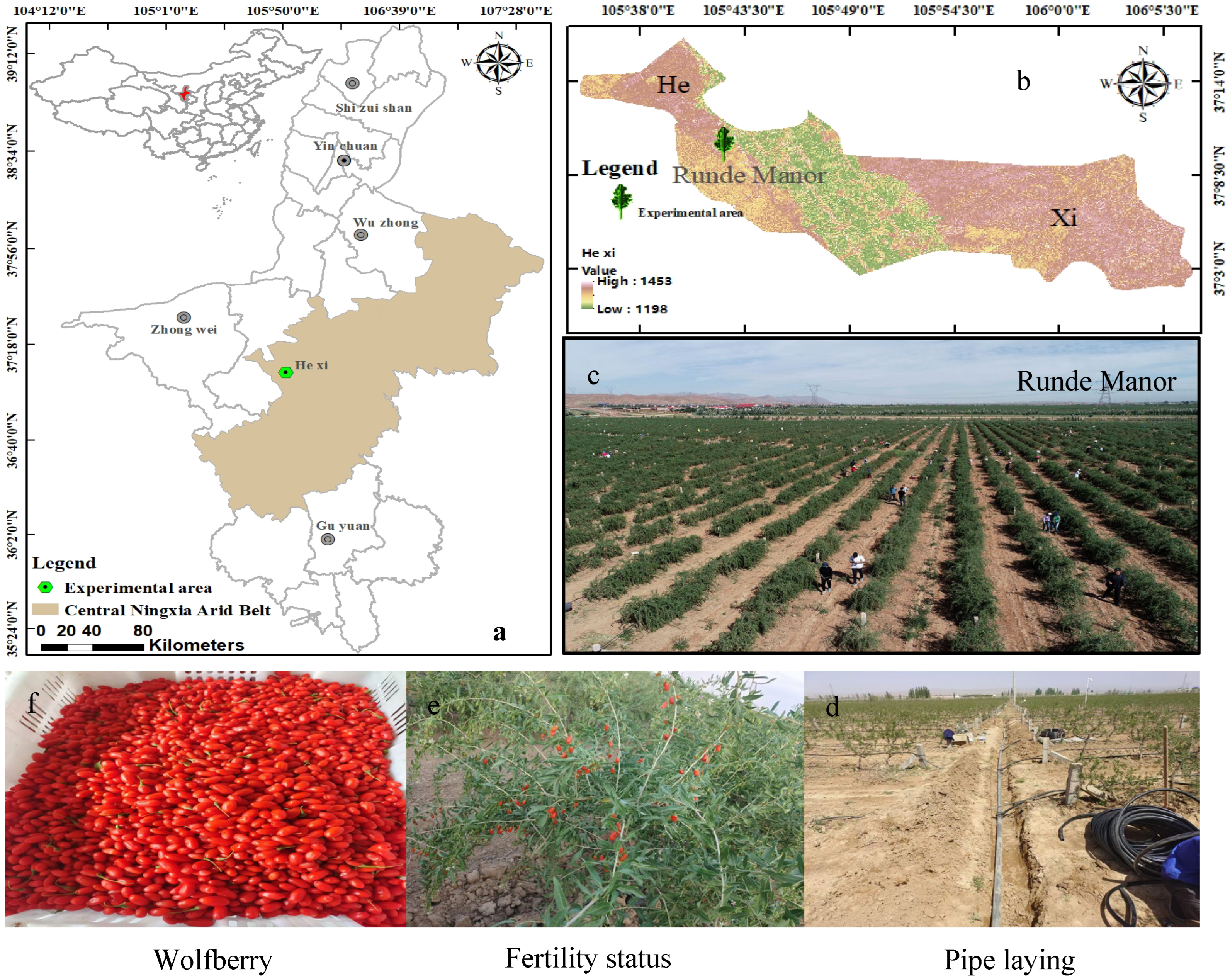
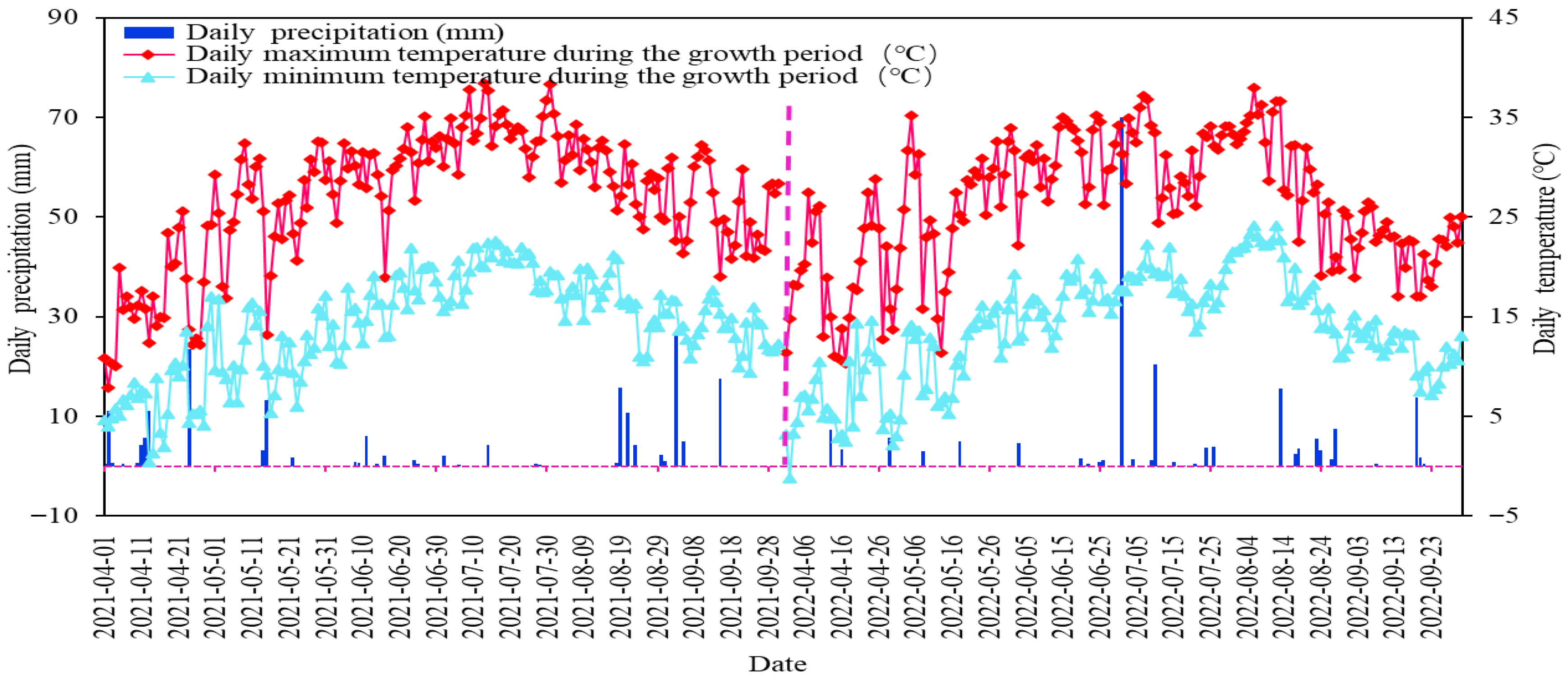
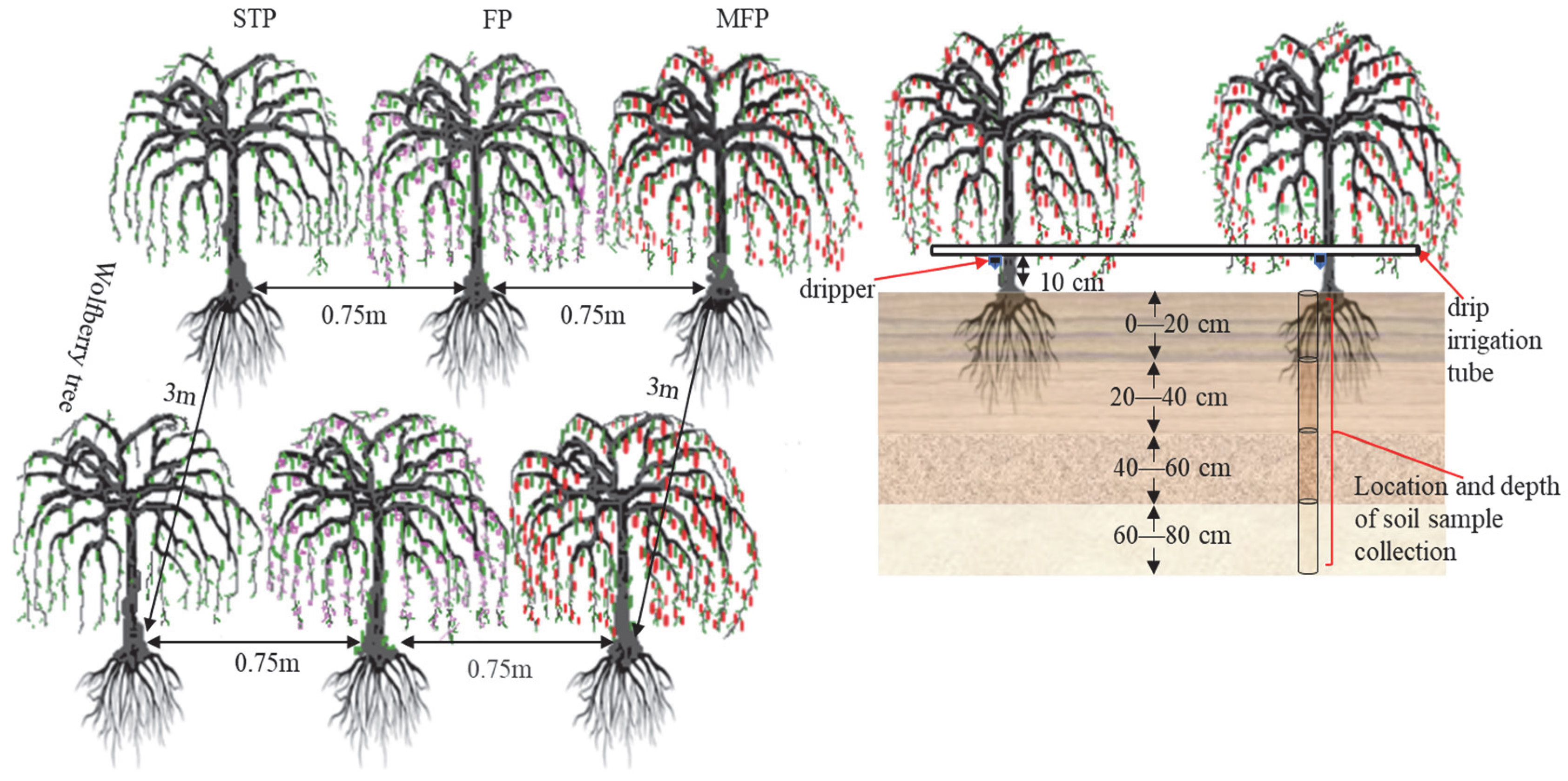
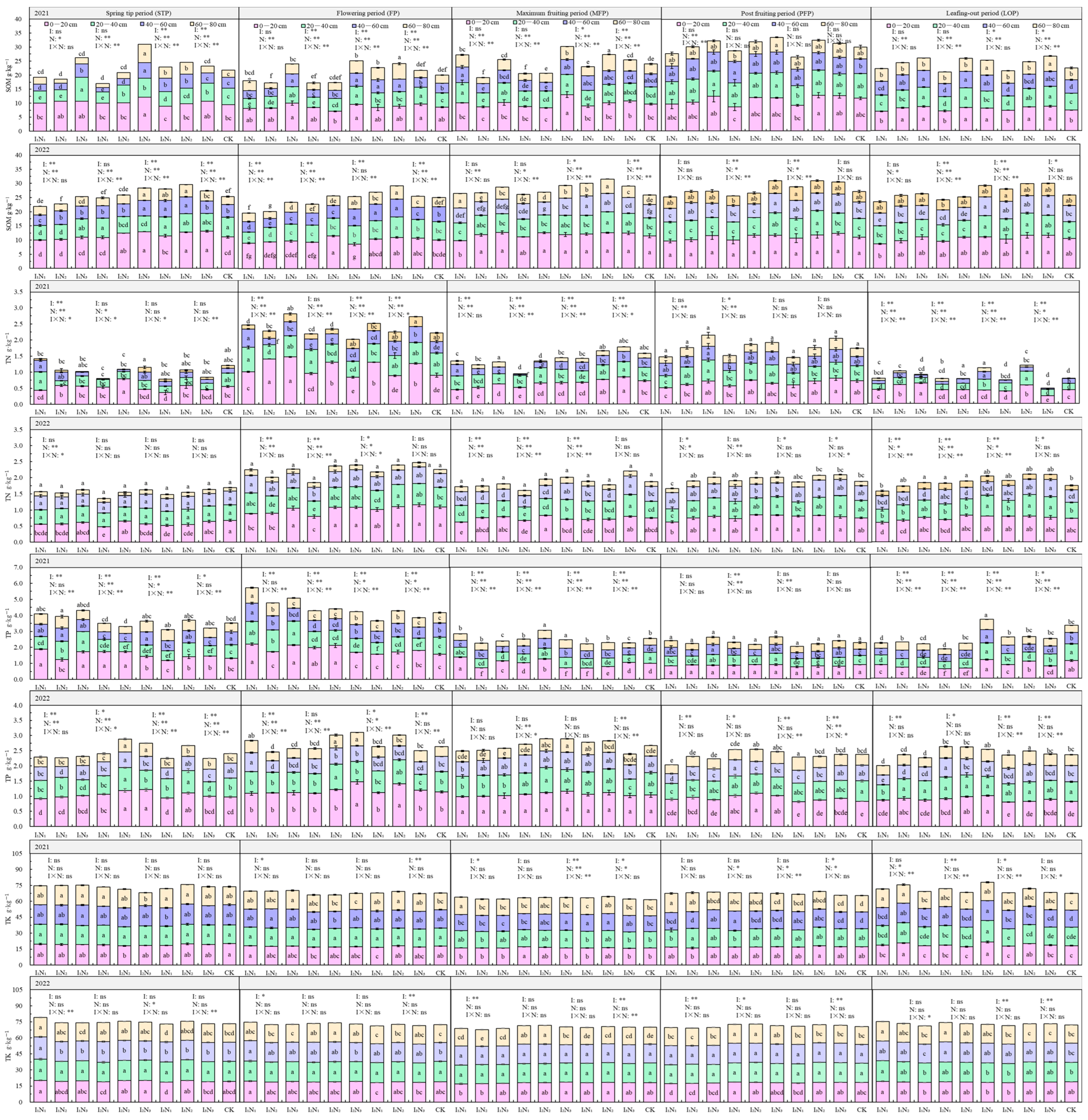
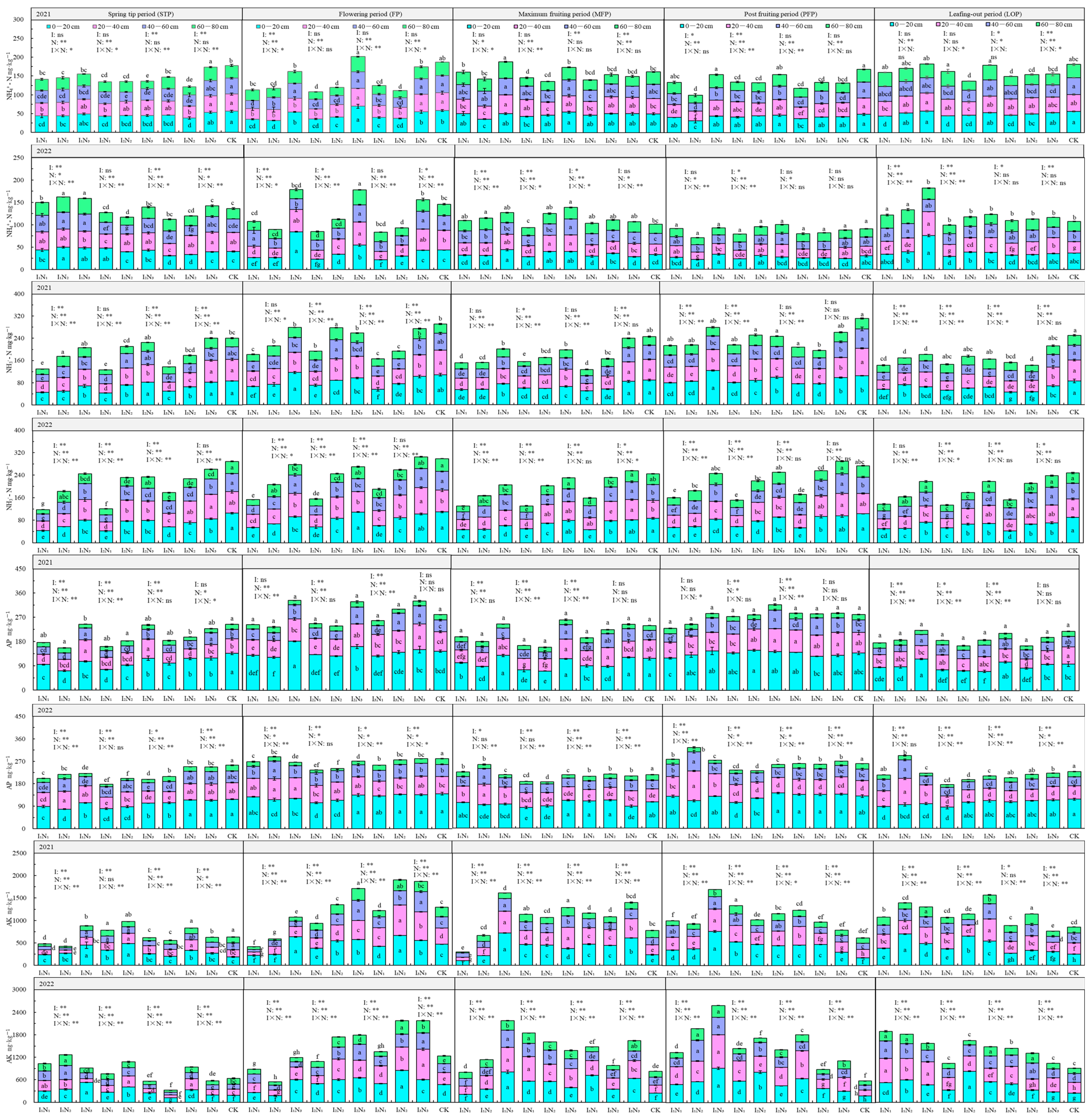
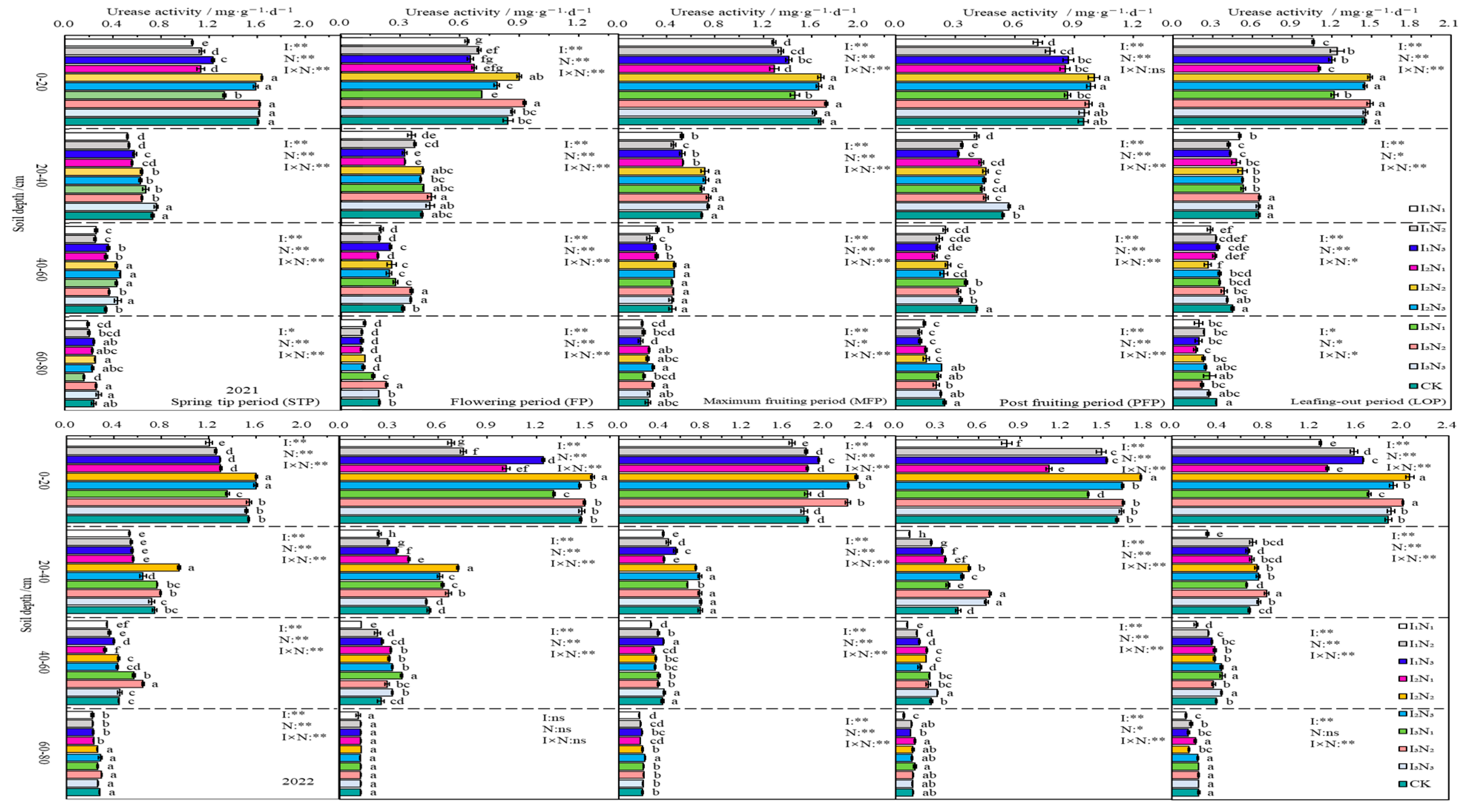
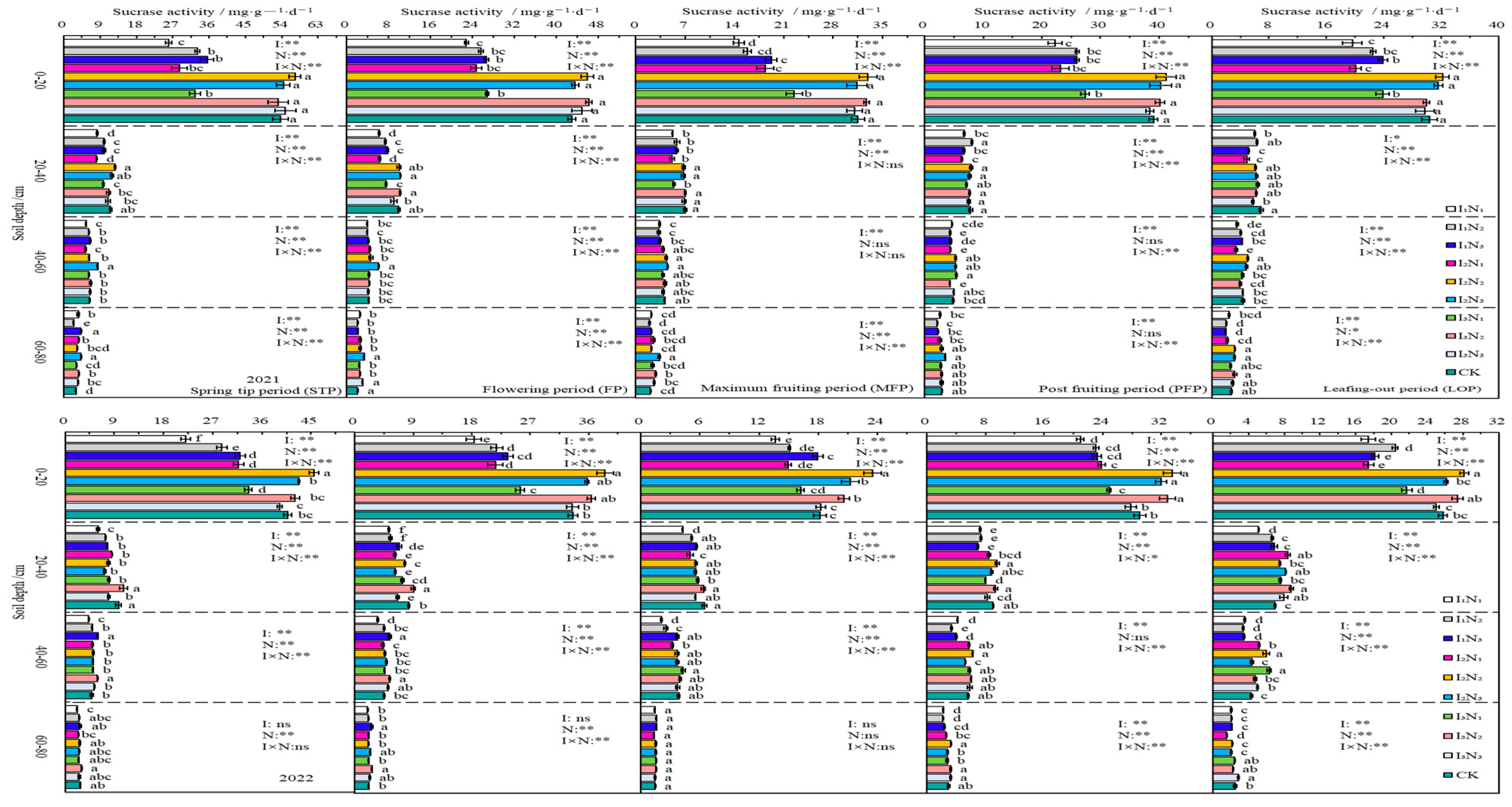
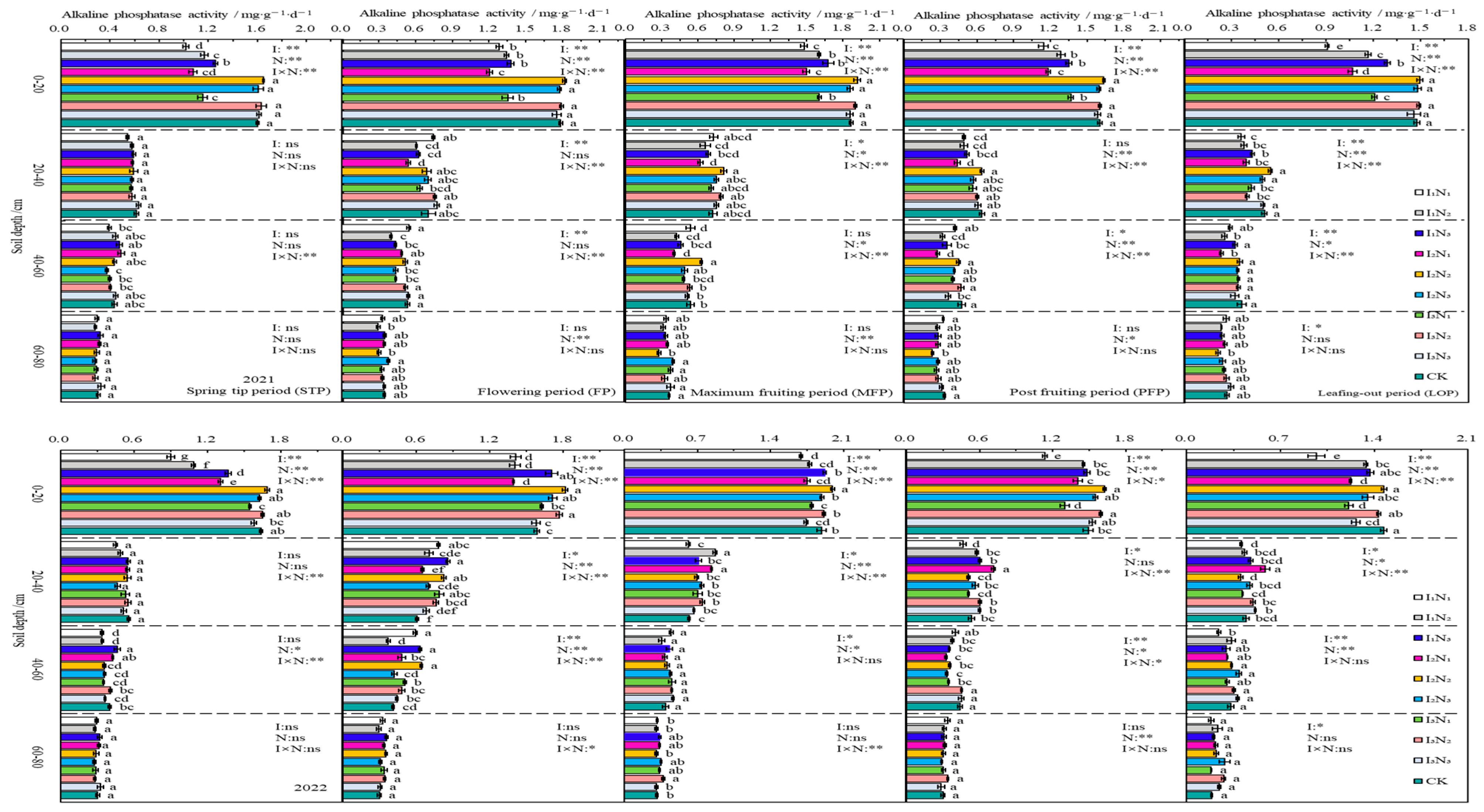
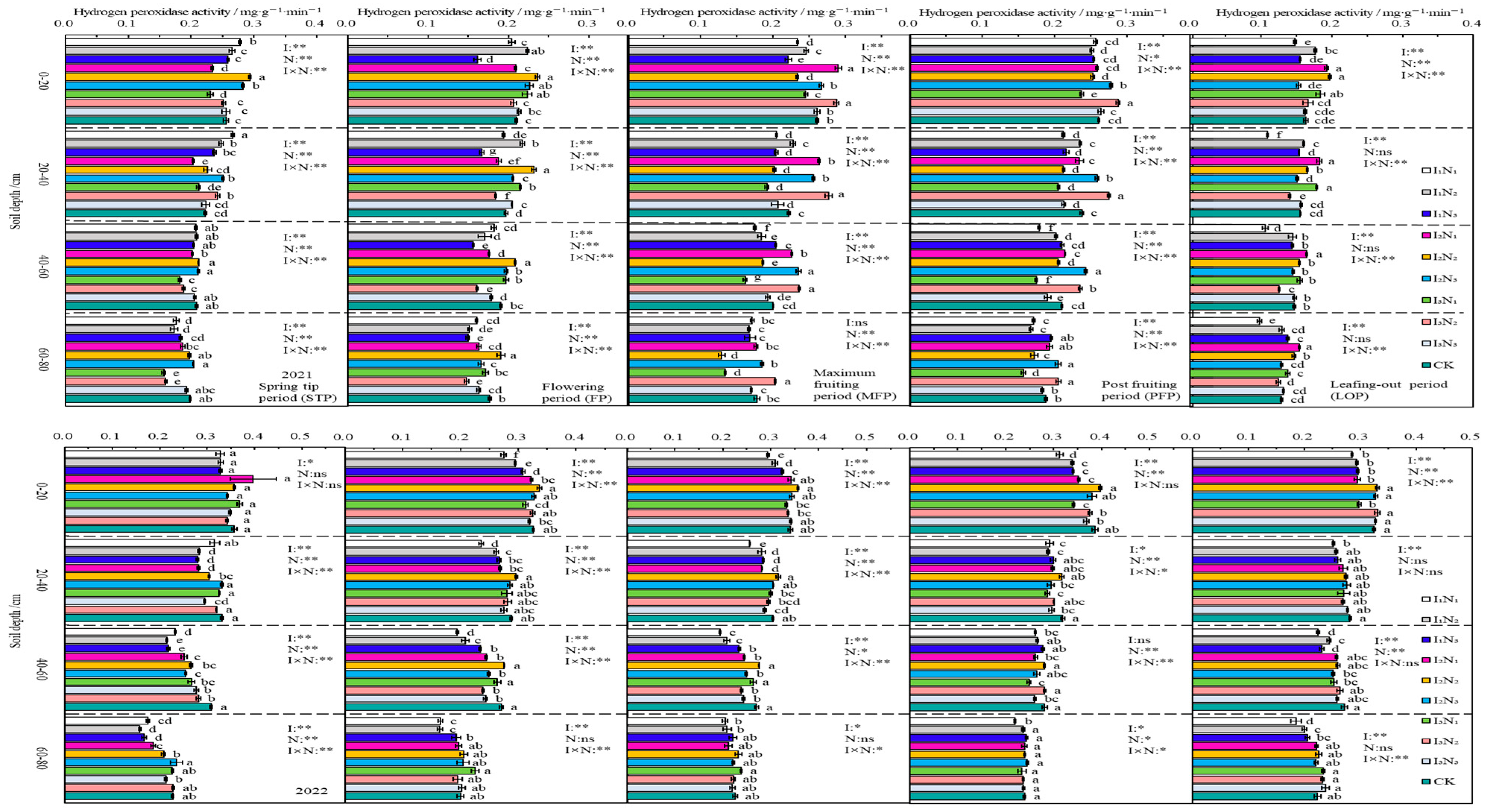
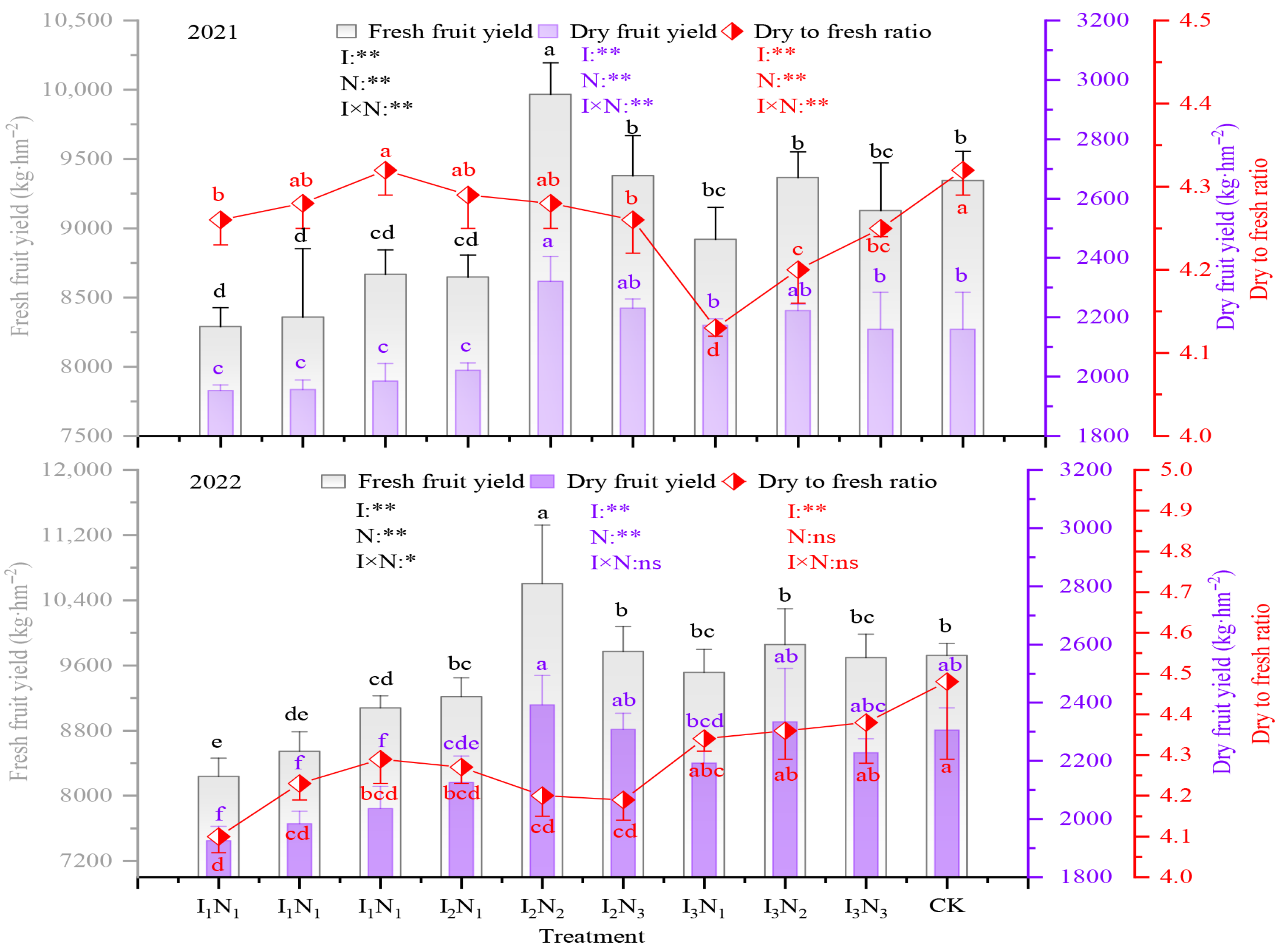
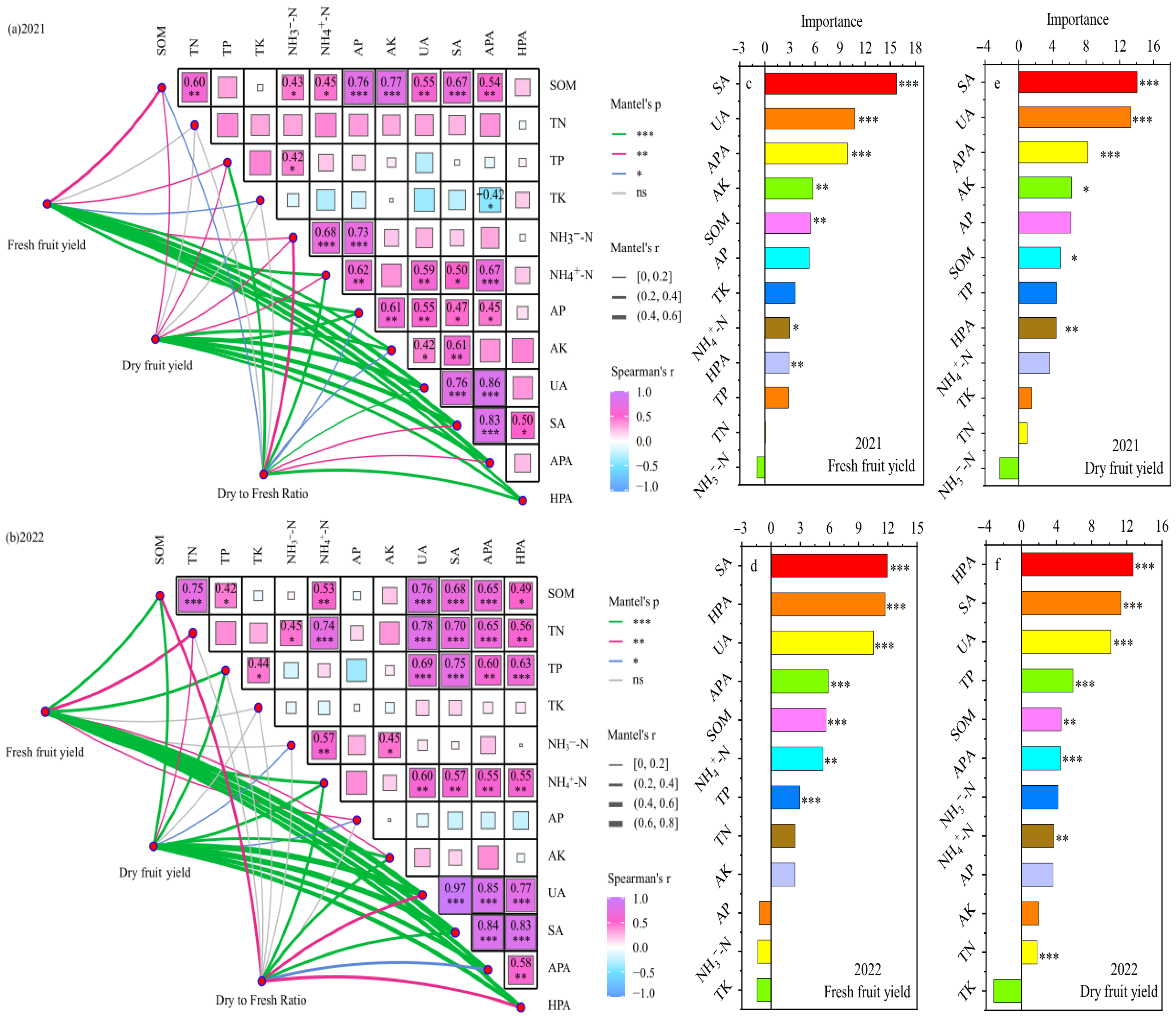
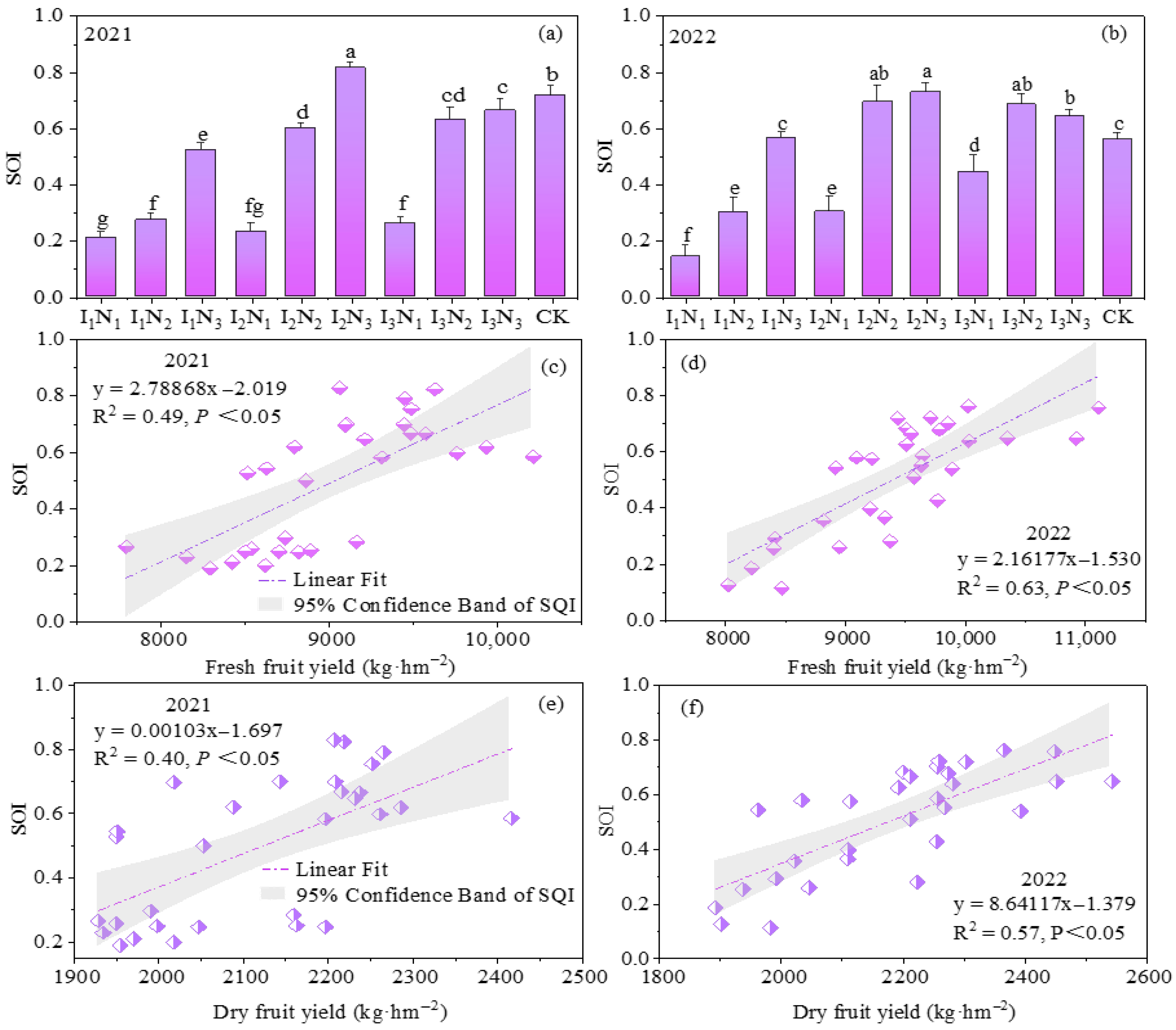
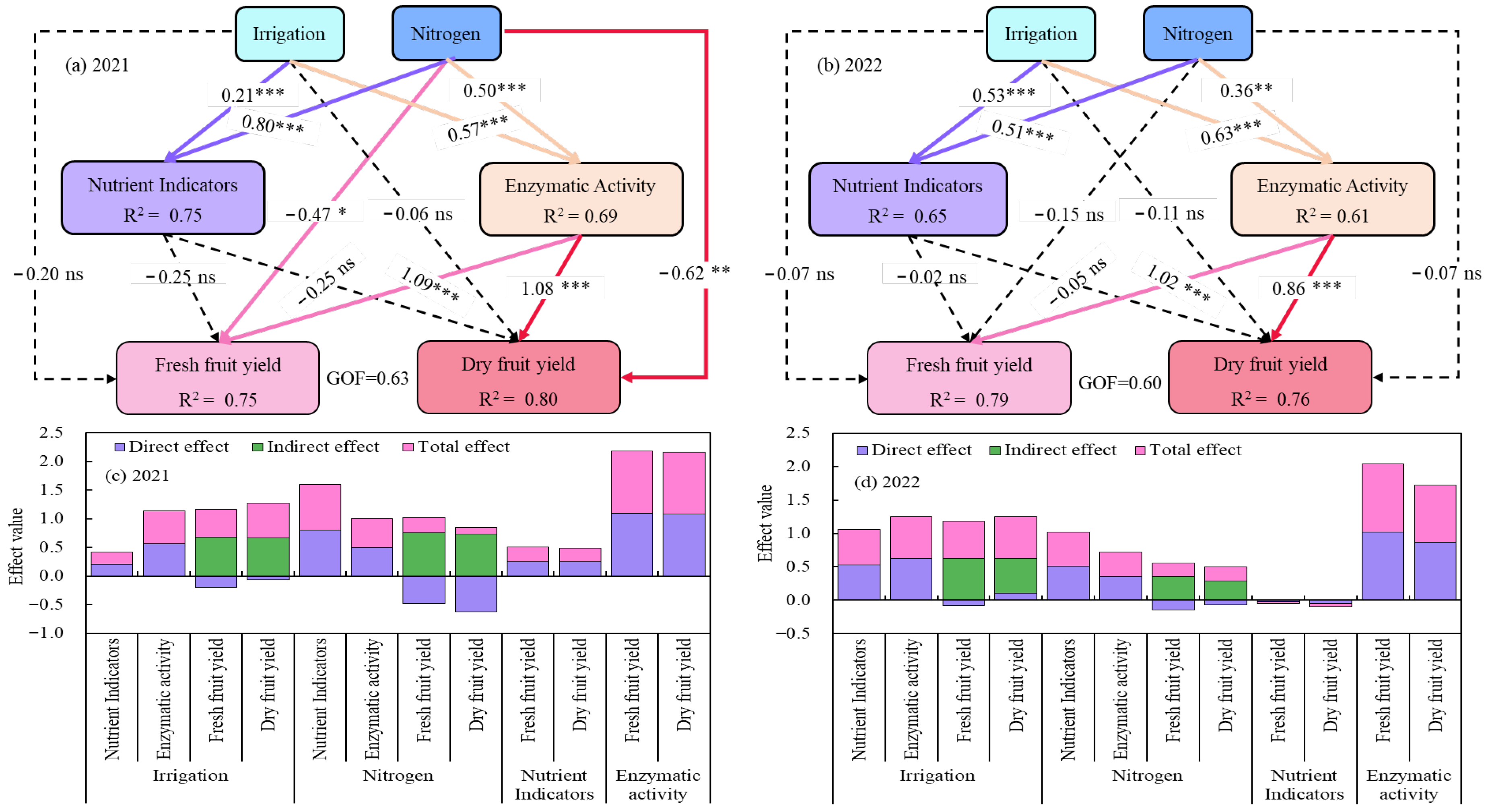
| Year | Depth | EC | pH | TN | TP | TK | SOM | NH4+-N | NO3−-N | A P | A K |
|---|---|---|---|---|---|---|---|---|---|---|---|
| cm | μs·cm−1 | g·kg−1 | mg·kg−1 | ||||||||
| 2021 | 0–20 | 1615 | 7.97 | 0.46 | 0.43 | 16.19 | 7.58 | 12.67 | 14.69 | 39.46 | 216.37 |
| 20–40 | 1091 | 8.14 | 0.42 | 0.42 | 17.15 | 6.73 | 4.51 | 4.73 | 26.65 | 150.05 | |
| 2022 | 0–20 | 1649 | 8.04 | 0.45 | 0.40 | 17.00 | 7.21 | 12.24 | 14.17 | 36.46 | 203.70 |
| 20–40 | 1075 | 8.18 | 0.41 | 0.41 | 17.00 | 6.28 | 4.42 | 4.82 | 25.21 | 126.23 | |
| Fertility Stages | Irrigation Amount/m3·hm−2 | Irrigation Ratio/% | Irrigation Amount/kg·hm−2 | N Application Rate/% | |||||
|---|---|---|---|---|---|---|---|---|---|
| I1 | I2 | I3 | N1 | N2 | N3 | ||||
| STP | 04–30 | 432 | 513.0 | 594 | 20 | 24.75 | 33.75 | 42.75 | 15 |
| FP | 05–23 | 216 | 256.5 | 297 | 30 | 12.38 | 16.88 | 21.38 | 25 |
| 06–18 | 432 | 513 | 594 | 28.88 | 39.38 | 49.88 | |||
| MFP | 07–05 | 216 | 256.5 | 297 | 40 | 20.63 | 28.13 | 35.63 | 50 |
| 07–15 | 216 | 256.5 | 297 | 20.63 | 28.13 | 35.63 | |||
| 07–25 | 216 | 256.5 | 297 | 20.63 | 28.13 | 35.63 | |||
| PFP | 08–05 | 216 | 256.5 | 297 | 10 | 20.63 | 28.13 | 35.63 | 10 |
| LOP | 08–25 | 216 | 256.5 | 297 | 10 | 16.50 | 22.50 | 28.50 | 10 |
| Total | 2160 | 2565 | 2970 | 100 | 165 | 225 | 285 | 100 | |
Disclaimer/Publisher’s Note: The statements, opinions and data contained in all publications are solely those of the individual author(s) and contributor(s) and not of MDPI and/or the editor(s). MDPI and/or the editor(s) disclaim responsibility for any injury to people or property resulting from any ideas, methods, instructions or products referred to in the content. |
© 2025 by the authors. Licensee MDPI, Basel, Switzerland. This article is an open access article distributed under the terms and conditions of the Creative Commons Attribution (CC BY) license (https://creativecommons.org/licenses/by/4.0/).
Share and Cite
Ma, Z.; Tang, M.; Fu, Q.; Ai, P.; Heng, T.; Li, F.; Jiang, P.; Ma, Y. Regulation Mechanisms of Water and Nitrogen Coupling on the Root-Zone Microenvironment and Yield in Drip-Irrigated Goji Berries. Agriculture 2025, 15, 2237. https://doi.org/10.3390/agriculture15212237
Ma Z, Tang M, Fu Q, Ai P, Heng T, Li F, Jiang P, Ma Y. Regulation Mechanisms of Water and Nitrogen Coupling on the Root-Zone Microenvironment and Yield in Drip-Irrigated Goji Berries. Agriculture. 2025; 15(21):2237. https://doi.org/10.3390/agriculture15212237
Chicago/Turabian StyleMa, Zhenghu, Maosong Tang, Qiuping Fu, Pengrui Ai, Tong Heng, Fengxiu Li, Pingan Jiang, and Yingjie Ma. 2025. "Regulation Mechanisms of Water and Nitrogen Coupling on the Root-Zone Microenvironment and Yield in Drip-Irrigated Goji Berries" Agriculture 15, no. 21: 2237. https://doi.org/10.3390/agriculture15212237
APA StyleMa, Z., Tang, M., Fu, Q., Ai, P., Heng, T., Li, F., Jiang, P., & Ma, Y. (2025). Regulation Mechanisms of Water and Nitrogen Coupling on the Root-Zone Microenvironment and Yield in Drip-Irrigated Goji Berries. Agriculture, 15(21), 2237. https://doi.org/10.3390/agriculture15212237





